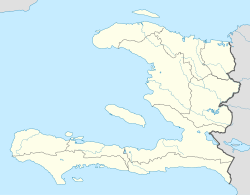Milot
Milo | |
|---|---|
 Milot from the gates of the Sans-Souci Palace | |
| Coordinates: 19°37′0″N 72°13′0″W / 19.61667°N 72.21667°W | |
| Country | Haiti |
| Department | Nord |
| Arrondissement | Acul-du-Nord |
| Population (2015) | |
| • Total | 31 992 |
| Communal Sections | 3 |

Milot (Haitian Creole: Milo) is a commune in the Nord department of Haiti, 12 miles south of Cap-Haïtien. It is the site of Sans-Souci Palace, one of Haiti's most revered landmarks.[1] The Citadelle Laferrière, Haiti's best-known landmark, is five miles (8 km) by road to the south. The town also hosts a hospital, Hôpital Sacré Coeur, run by the Sovereign Military Order of Malta and the Crudem Foundation.[2]
YouTube Encyclopedic
-
1/3Views:59 9102 4174 613
-
La Bonne Nouvelle Milot
-
On The Road To Milot in (Cap-Haitian, Haiti) GoPro3
-
#Checkout | Palais Sans Souci | Milot | Haiti
Transcription
Communal Sections
The commune consists of three communal sections, namely:
- Perches-de-Bonnet, rural
- Bonnet à l'Evêque, urban (town of Milot) and rural
- Genipailler, urban (Carrefour des Pères neighborhood) and rural
History
The earliest documentation of inhabitants in Milot is 1786, when there was a small plantation in the area.[3] Milot's growth was strongly shaped by the Haitian revolutionary Henri Christophe. From 1802 to 1804, Milot was the base of his military operations. It grew further after the Haitian Declaration of Independence marked the end of the revolution, becoming a small town by 1806. At this time, it may have consisted of 160 houses with 500 residents.[3]
References
- ^ Geller, Pamela L; Marcelin, Louis Herns (2020). "In the shadow of the Citadel: Haitian national patrimony and vernacular concerns". Journal of Social Archaeology. 20 (1): 49–73. doi:10.1177/1469605319883483. ISSN 1469-6053.
- ^ "Home". The CRUDEM Foundation, Inc. Retrieved 2024-02-11.
- ^ a b Monroe, J. Cameron (2020-10-01). "Sovereignty after Slavery: Universal Liberty and the Practice of Authority in Postrevolutionary Haiti". Current Anthropology. 61 (S22): S232–S247. doi:10.1086/710104. ISSN 0011-3204.
External links
 Media related to Milot at Wikimedia Commons
Media related to Milot at Wikimedia Commons
19°36′17″N 72°13′07″W / 19.604692°N 72.218596°W


